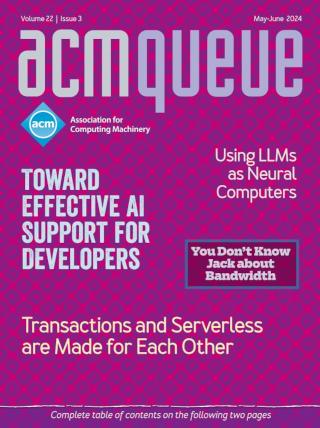
Overly Attached:
Know when to let go of emotional attachment to your work.
A smart, senior engineer couldn’t make logical decisions if it meant deprecating the system he and his team had worked on for a number of years. Even though the best thing would have been to help another team create the replacement system, they didn’t want to entertain the idea because it would mean putting an end to something they had invested so much in. It is good to have strong ownership, but what happens when you get too attached?
GAN Dissection and Datacenter RPCs:
Visualizing and understanding generative adversarial networks; datacenter RPCs can be general and fast.
Image generation using GANs (generative adversarial networks) has made astonishing progress over the past few years. While staring in wonder at some of the incredible images, it’s natural to ask how such feats are possible. "GAN Dissection: Visualizing and Understanding Generative Adversarial Networks" gives us a look under the hood to see what kinds of things are being learned by GAN units, and how manipulating those units can affect the generated images. February saw the 16th edition of the Usenix Symposium on Networked Systems Design and Implementation. Kalia et al. blew me away with their work on fast RPCs (remote procedure calls) in the datacenter. Through a carefully considered design, they show that RPC performance with commodity CPUs and standard lossy Ethernet can be competitive with specialized systems based on FPGAs (field-programmable gate arrays), programmable switches, and RDMA (remote direct memory access). It’s a fabulous reminder to ensure we’re making the most of what we already have before leaping to more expensive solutions.
Extract, Shoehorn, and Load:
Data doesn’t always fit nicely into a new home.
It turns out that the business value of ill-fitting data is extremely high. The process of taking the input data, discarding what doesn’t fit, adding default or null values for missing stuff, and generally shoehorning it to the prescribed shape is important. The prescribed shape is usually one that is amenable to analysis for deeper meaning.
MUST and MUST NOT:
On writing documentation
Pronouncements without background or explanatory material are useless to those who are not also deeply steeped in the art and science of computer security or security in general. It takes a particular bend of mind to think like an attacker and a defender all at once, and most people are incapable of doing this; so, if you want the people reading the document to follow your guidance, then you must take them on a journey from ignorance to knowledge.
Surviving Software Dependencies:
Software reuse is finally here but comes with risks.
Software reuse is finally here, and its benefits should not be understated, but we’ve accepted this transformation without completely thinking through the potential consequences. The Copay and Equifax attacks are clear warnings of real problems in the way software dependencies are consumed today. There’s a lot of good software out there. Let’s work together to find out how to reuse it safely.
The DevOps Phenomenon:
An executive crash course
Stressful emergency releases are a thing of the past for companies that subscribe to the DevOps method of software development and delivery. New releases are frequent. Bugs are fixed rapidly. New business opportunities are sought with gusto and confidence. New features are released, revised, and improved with rapid iterations. DevOps presents a strategic advantage for organizations when compared with traditional software-development methods. Leadership plays an important role during that transformation. DevOps is about providing guidelines for faster time to market of new software features and achieving a higher level of stability. Implementing cross-functional, product-oriented teams helps bridge the gaps between software development and operations. By ensuring their transformations include all of the principles outlined in CALMS, teams can achieve superior performance and deliver value to their organizations. DevOps is often challenging, but stories from across the industry show that many organizations have already overcome the early hurdles and plan to continue their progress, citing the value to their organizations and the benefits to their engineers.
Industry-scale Knowledge Graphs: Lessons and Challenges:
Five diverse technology companies show how it’s done
This article looks at the knowledge graphs of five diverse tech companies, comparing the similarities and differences in their respective experiences of building and using the graphs, and discussing the challenges that all knowledge-driven enterprises face today. The collection of knowledge graphs discussed here covers the breadth of applications, from search, to product descriptions, to social networks.
Access Controls and Health Care Records: Who Owns the Data?:
A discussion with David Evans, Richard McDonald, and Terry Coatta
What if health care records were handled in more of a patient-centric manner, using systems and networks that allow data to be readily shared by all the physicians, clinics, hospitals, and pharmacies a person might choose to share them with or have occasion to visit? And, more radically, what if it was the patients who owned the data?





